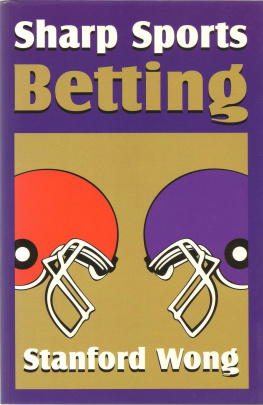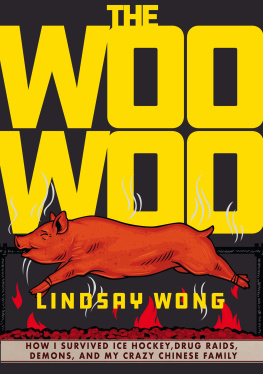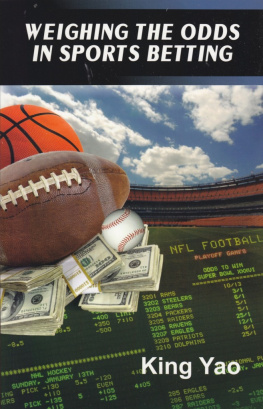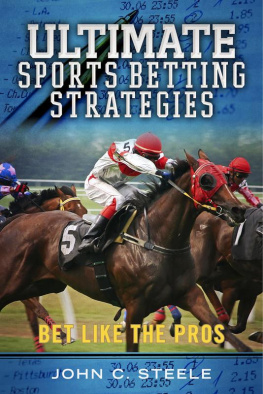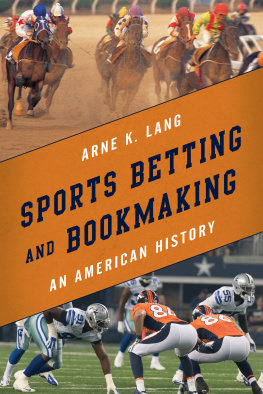Wong - Sharp Sports Betting
Here you can read online Wong - Sharp Sports Betting full text of the book (entire story) in english for free. Download pdf and epub, get meaning, cover and reviews about this ebook. City: United States, year: 2011, publisher: PiYee Press, genre: Romance novel. Description of the work, (preface) as well as reviews are available. Best literature library LitArk.com created for fans of good reading and offers a wide selection of genres:
Romance novel
Science fiction
Adventure
Detective
Science
History
Home and family
Prose
Art
Politics
Computer
Non-fiction
Religion
Business
Children
Humor
Choose a favorite category and find really read worthwhile books. Enjoy immersion in the world of imagination, feel the emotions of the characters or learn something new for yourself, make an fascinating discovery.
- Book:Sharp Sports Betting
- Author:
- Publisher:PiYee Press
- Genre:
- Year:2011
- City:United States
- Rating:5 / 5
- Favourites:Add to favourites
- Your mark:
- 100
- 1
- 2
- 3
- 4
- 5
Sharp Sports Betting: summary, description and annotation
We offer to read an annotation, description, summary or preface (depends on what the author of the book "Sharp Sports Betting" wrote himself). If you haven't found the necessary information about the book — write in the comments, we will try to find it.
Wong: author's other books
Who wrote Sharp Sports Betting? Find out the surname, the name of the author of the book and a list of all author's works by series.
Sharp Sports Betting — read online for free the complete book (whole text) full work
Below is the text of the book, divided by pages. System saving the place of the last page read, allows you to conveniently read the book "Sharp Sports Betting" online for free, without having to search again every time where you left off. Put a bookmark, and you can go to the page where you finished reading at any time.
Font size:
Interval:
Bookmark:
copyright 2001, 2006, 2009, 2011 by Pi Yee Press
Inquiries should be addressed to Pi Yee Press, 4855 W. Nevso Dr., Las Vegas, NV 89103-3787.
ISBN 978-0-935926-44-6
This book is dedicated to Bob Martin (1918-2001), Nevadas first great linesmaker. The lines he crafted for the Churchill Downs sportsbook in the 1960s became known internationally as the Las Vegas line.
Stanford Wong has made a name for himself through books, newsletters, software, and the Internet. He loves to solve puzzles.
Of course he has done his share of winning at gambling games. When he was in graduate school, playing blackjack was his major source of income, and he stayed in school long enough to earn a Ph.D. from Stanford. He published his first book, Professional Blackjack, in 1975 while a student at Stanford.
Wong is a frequent contributor to the message boards on his website, BJ21.com, which is devoted to discussion of getting an edge at casino games.
Early drafts of this book were posted chapter by chapter on BJ21.com. Comments made by BJ21.coms green chippers have been incorporated into the final version of the book. Sharp Sports Betting is a better book because of that feedback. That process allowed the book to be finished more quickly than would have been the case had draft chapters not been posted to the Internet. If you write a book of your own, I heartily recommend posting it on the Internet chapter by chapter as you are writing it.
Don Schlesinger has been most helpful in improving the manuscript.
David Matthews wrote the first draft of chapter 3, Betting Sports on the Internet, and helped edit the whole book. That chapter was revised for the 2006 edition with the help of Goats and Eddie Dingle.
Some of the tables in this book might be images, which cannot be read as text. If you want to access those tables in a format that can be read as text, go to:
http://BJ21.com/books/SSB/tables.shtml.
Sharp Sports Betting is a tool for those interested in winning money at sports betting. This book explains the most common sports bets, what all the numbers mean, and the mathematics behind the numbers.
Sports bettors have their own lingo. If you are new to sports betting, you will appreciate the glossary at the back of the book.
The first half of the book contains general information about betting that applies to all sports. The last half of the book has information specific to the National Football League.
This book is not a get-rich-quick vehicle. If you are looking for a magic formula in which you input data and grind out numbers that will tell you who will win tomorrows games, you might be disappointed in this book.
But if you are facing two different ways to bet the same team, you might find this book helpful in choosing the better alternative.
The advice in this book will help you find worthwhile sports bets, but dont quit your job to become a full-time sports bettor.
Sports betting is one of the more popular ways to gamble. In the United States, at the time of this writing, betting on sports is legal only in the sportsbooks of Nevada, in the Oregon lottery, and on Florida cruise ships once they get three miles out.
Outside of the United States, betting on sports is legal on the Internet and in many countries. It is legal in Mexico, and some Mexican sportsbooks are located within walking distance of the US border. Betting on sports enjoys the reputation of being well regulated in Great Britain and Australia.
The most common way to bet football is against the spread. Think of the spread as being a handicap, the number of points that must be added to or subtracted from one teams final score to induce bettors to back both teams.
The most common terms for betting sports are -110, which means risking $110 in an attempt to win $100. You give the sportsbook $110 when you make your bet, and get a receipt with the details of your bet printed on it. If your team wins, you take that receipt back to the sportsbook and receive $210 your own $110 and the $100 you won. If your team loses, your receipt is worthless. If your team wins but you cannot find your receipt, keep looking because without that receipt you will have difficulty getting paid.
If you walk into a sportsbook, you will see a collection of numbers that at first may make no sense to you. But with some learning, you will be able to understand what the numbers mean. With a bit of study, you will occasionally find a number that jumps out at you as being a good bet.
The area where all the numbers are displayed is called a board, a term left over from the days when all the numbers were entered by hand on wall boards. Nowadays electronic displays are more common than actual boards.
The first thing to notice is that the display of numbers is organized by sport. Depending on the time of year, you may find a section of the board devoted to NFL football, college football, major-league baseball, NBA basketball, college basketball, golf, auto racing, and probably more.
Each sport has its own system of displaying possible bets.
Generally there will be sheets of paper available with the various possible sports bets listed on them. In the event of differences between the odds listed on the sheets of paper and on the board, the board is more current. The odds on the sheets of paper were accurate when the sheets were printed, but at best that was earlier in the day and it might have been several days ago.
The main value of the sheets is to list all the bets by their unique numbers. You bet by number. You dont say Give me $100 on the Yankees, you say Give me $100 on number 302 or whatever number is listed to the left of the Yankees on the sheet of paper and on the board.
Football
Look closely at the football listings and you will find a lot of information. The teams are listed in pairs, and the bottom team by convention is the home team.
One of the teams will have a small number to the right of it, such as 3 or 5.5. The other team will have a larger number listed to the right of it, such as 37 or 40.5. The smaller number is the spread and the larger number is the total. Experienced sports bettors know that, so there is no reason to label them as spread and total on the board.
As stated above, the number to the left of the teams name is the unique number assigned to that team to avoid confusion when you bet.
The number giving the spread will be next to the team that is the favorite. That number is understood to be a negative number, though to save space the board might have eliminated the negative signs.
The number giving the total will be next to the name of the underdog.
Sometimes there will be a money line listed, and sometimes there will be no money line. Usually the money line is identified somehow as the money line, perhaps with M/L. If there is a money line listed, it generally will be off to the right of the spread and totals. Each team will have its own money line.
The most popular way to bet football is against the spread. When someone says he is betting the Bears, what he usually means is he is betting on the Bears to cover the spread. If the Bears are favored by four points, then a bet on the Bears means Bears -4. If the Bears win by more than four points, the bet wins. If the Bears win by fewer than four points or lose the game, then a bet on Bears -4 is a loser.
If a game falls right on the spread, backers of both teams get their money back. That happened in a big way in Super Bowl XXXIV. The Rams were favored by seven over the Titans, and the final score was Rams 23, Titans 16. Sportsbooks took in a lot of money that then had to be refunded.
Next pageFont size:
Interval:
Bookmark:
Similar books «Sharp Sports Betting»
Look at similar books to Sharp Sports Betting. We have selected literature similar in name and meaning in the hope of providing readers with more options to find new, interesting, not yet read works.
Discussion, reviews of the book Sharp Sports Betting and just readers' own opinions. Leave your comments, write what you think about the work, its meaning or the main characters. Specify what exactly you liked and what you didn't like, and why you think so.

